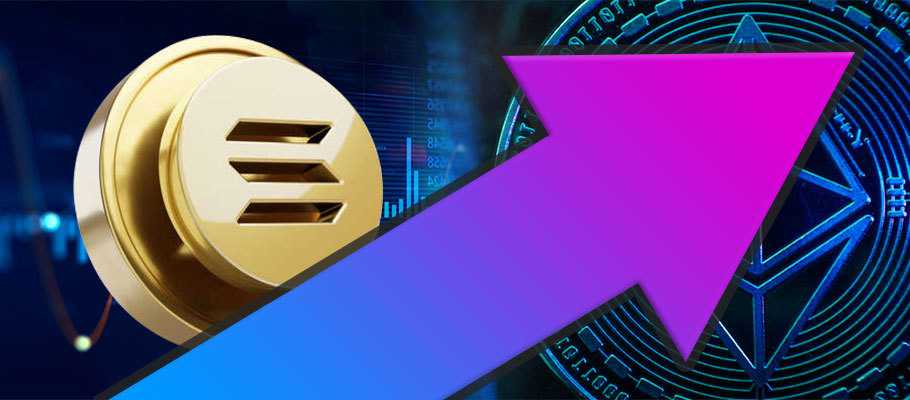
Published: August 23rd, 2021
SOL, the native cryptocurrency of super-fast blockchain network Solana, is on a roll. Its price hit another all-time high of USD 79.56 last week, continuing a meteoric rise that’s seen its price nearly double in less than a week.
According to data from CoinGecko, SOL’s price was sitting at just under USD 39 on 12th August, rocketing up 96 per cent on 18th August. Earlier in the year, SOL peaked above USD 55 in May before the cryptocurrency market’s rapid Springtime decent began. SOL had actually reached a low of under USD 24 on 20th July.
Now, as the broader crypto market bounces back, Solana is soaring. Its gains, though, are well ahead of the pack. Only AUDIO from decentralised music service Audius posted higher gains last week, off the back of a partnership announcement with TikTok.
What’s going on with SOL?
Solana is a proof-of-stake blockchain created as an alternative to Ethereum, the leading DeFi platform. Smart contracts are software components that execute set instructions automatically, and they’re vital to a wide array of decentralised finance services, including peer-to-peer trading and lending.
While Ethereum is the most popular platform for DeFi and other kinds of decentralised apps (dapps), Solana is engineered for speed. It can handle a much higher volume of transactions than Ethereum, close to 2,000 times more per second than its more mature older cousin.
Ethereum has plans to bridge the gap. There are solutions like Polygon that work alongside the mainnet blockchain to accelerate transaction handling, and Ethereum is in the process of upgrading to a more efficient proof-of-stake network model. For now, however, Solana is chipping away at Ethereum’s dominance as more and more developers take advantage of the edge it has in transaction speed.
Solana-based DeFi applications are on fire. The amount of value locked in Solana DeFi contracts passed by USD 2 billion last week. Rising to USD 2.2 billion at time of writing. That’s partly due to the SOL token’s rising value (see below).
Solana’s developers recently announced a new event, Solana Breakpoint, which will be the first annual developer conference dedicated to the ecosystem. It’s scheduled for 7-10 November in Lisbon, Portugal, though dates could change if new COVID-19 restrictions are enacted in the country.
On 14th August, Solana’s SOL crypto token soared to an all-time high of USD 63.32, posting a gain of more than 36.7 per cent over the previous week.
Numbers from CoinGecko showed the altcoin also crossed over into the crypto market cap top 10, surging past Uniswap’s UNI with USD 17.73 billion.
SOL’s dramatic surge came in the wake of the Degenerate Ape Academy (DAA) launch. DAA is a non-fungible token (NFT) developed on the Solana blockchain. Its launch saw the NFT’d collection of 10,000 cartoon ape pictures sell out in just over seven minutes, with the overall trading volume exceeding 95,000 SOL (valued at more than USD 5.7 million).
The fee for creating a ‘digital ape’ was 5 SOL. Now, as the project is sold out, the price for a DAA NFT collectable on the Solanart marketplace is currently 14.3 SOL. That means anyone who was lucky enough to get in the queue for an ape and buy one will have doubled their investment.
At time of writing, the price for one degenerate ape had leapt past 100,000 SOL, or over USD 6.1 million.
Solana’s proof of stake (PoS) consensus algorithm boasts processing speeds of 50,000 transactions per second (TPS) at peak load, or close to 2,000 times faster than Ethereum’s top transaction speed.
Solana also boasts cheap transaction fees, something that helps it compete for new projects. Solana also has the Solanart NFT marketplace, which hosts crypto artworks like Digital Ape and other digital collectables.
After the network’s sponsorship of the Lollapalooza music festival in July, the frenzied buying around Digital Ape Academy has added to the buzz around Solana.
On 18th August, numbers from statistics company DeFi Llama showed that the Solana network had reached USD 2 billion in total value locked (TVL), a new milestone for the network. TVL measures the volume of crypto assets tied up in a DeFi network’s protocols.
Though DeFi started out on Ethereum, where nearly USD 100 billion is locked in protocols like Uniswap, Aave, and Compound, the market has started branching out to other blockchains, the biggest being Binance Smart Chain with USD 16 billion in TVL. Those protocols make it possible to execute a wide range of financial transactions, from loans to earned interest and asset swaps, without a centralised middleman taking a cut. The transactions happen through ‘smart contracts,’ which act as automated intermediaries.
Solana has made its own play for DeFi developers to woo more users over from Ethereum, which has proved to be slow and expensive in comparison. Its leading position as a development platform means it also struggles to react to the growing demand for DeFi applications and surging interest in NFTs.
Solana’s team of developers says the upstart network is already where Ethereum wants to be after it transitions to Eth 2.0, which promises to be a faster, more scalable network that counts transaction fees in pennies, not pounds.
Solana's plans to overtake its older cousin have been complicated somewhat by the arrival of Polygon, a network built on top of Ethereum that’s designed to relieve some of the current DeFi- and NFT-driven workload. Numbers from DeFi Llama show it boasts USD 5.3 billion in TVL assets of its own, meaning there’s more money locked into Aave’s Polygon version of DeFi than the total TVL on Solana.
Ethereum ‘killers’ emerged before, only to fade in price or usage. Solana is enjoying a moment in the sun. Markets will have to watch and see if it gets burned.